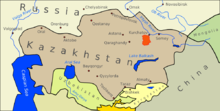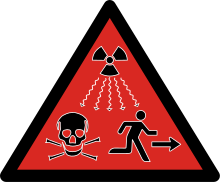Radioactive contamination




Radioactive contamination or radiological contamination is the contamination of the environment with radioactive materials, where these materials are not present. Many radioactive substances have very long half lives; this means that if they are present in the envioroment, they can be dangerous for a very long time. Many nuclear power plants produce such substances; usually they are processed to radioactive waste. There is little danger that comes from radioactive waste,if it is stored safely.
Causes[change | change source]
- Incidents in nuclear power plants
- Nuclear medicine uses radiation for the treatment of illnesses. Sometimes, there are accidents.
- Explosions in nuclear facilities (and atomic bombs) cause nuclear fallouts: This means that nuclear particles are scattered using normal atmospheric phenomena, such as the weather
- Nuclear reprocessing can contaminate water
Accidents[change | change source]
References[change | change source]
- ↑ Richard Schiffman (12 March 2013). "Two years on, America hasn't learned lessons of Fukushima nuclear disaster". The Guardian.
- ↑ Martin Fackler (June 1, 2011). "Report Finds Japan Underestimated Tsunami Danger". New York Times.
- ↑ Togzhan Kassenova (28 September 2009). "The lasting toll of Semipalatinsk's nuclear testing". Bulletin of the Atomic Scientists.
- ↑ 4.0 4.1 Goldfarb, Alex; Litvinenko, Marina (2007). Death of a Dissident: The Poisoning of Alexander Litvinenko and the Return of the KGB. Simon & Schuster UK. ISBN 978-1-4711-0301-8.
- ↑ Johnston, Wm. Robert. "K-19 submarine reactor accident, 1961". Database of radiological incidents and related events. Johnston's Archive. Retrieved 24 May 2012.
- ↑ Johnston, Wm. Robert. "K-27 submarine reactor accident, 1968". Database of radiological incidents and related events. Johnston's Archive. Retrieved 24 May 2012.
- ↑ Johnston, Wm. Robert. "K-431 submarine reactor accident, 1985". Database of radiological incidents and related events. Johnston's Archive. Retrieved 24 May 2012.
- ↑ "Lost Iridium-192 Source".
- ↑ The Radiological Accident in Goiania p. 2.
- ↑ Strengthening the Safety of Radiation Sources Archived 2009-03-26 at the Wayback Machine p. 15.
- ↑ Gusev, Igor; Guskova, Angelina; Mettler, Fred A. (12 December 2010). Medical Management of Radiation Accidents, Second Edition. CRC Press. pp. 299–303. ISBN 978-1-4200-3719-7.
- ↑ 12.0 12.1 Bagla, Pallava (7 May 2010). "Radiation Accident a 'Wake-Up Call' For India's Scientific Community". Science. 328 (5979): 679. Bibcode:2010Sci...328..679B. doi:10.1126/science.328.5979.679-a. PMID 20448162.
- ↑ International Atomic Energy Agency. "Investigation of an accidental Exposure of radiotherapy patients in Panama" (PDF).
- ↑ Johnston, Robert (September 23, 2007). "Deadliest radiation accidents and other events causing radiation casualties". Database of Radiological Incidents and Related Events.
- ↑ Patterson AJ (2007). "Ushering in the era of nuclear terrorism". Critical Care Medicine. 35 (3): 953–4. doi:10.1097/01.CCM.0000257229.97208.76. PMID 17421087.
- ↑ Acton JM, Rogers MB, Zimmerman PD; Brooke Rogers; Zimmerman (September 2007). "Beyond the Dirty Bomb: Re-thinking Radiological Terror". Survival. 49 (3): 151–168. doi:10.1080/00396330701564760. S2CID 154617638.
{{cite journal}}: CS1 maint: multiple names: authors list (link) - ↑ Sixsmith, Martin (2007). The Litvinenko File: The Life and Death of a Russian Spy. True Crime. p. 14. ISBN 978-0-312-37668-0.
- ↑ Bremer Mærli, Morten. "Radiological Terrorism: "Soft Killers"". Bellona Foundation. Archived from the original on 2007-12-17. Retrieved 2014-11-15.
